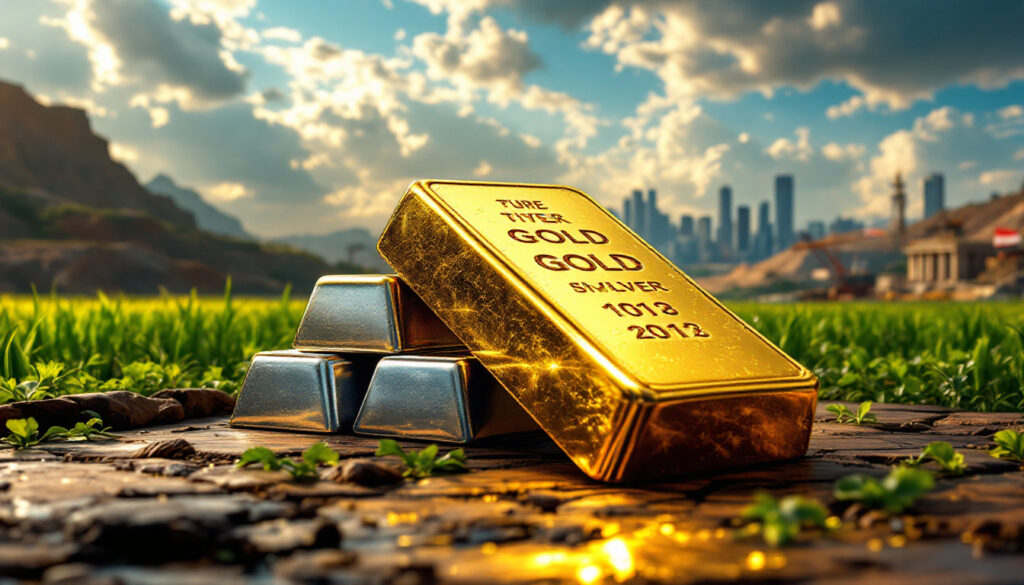Understanding the Gold and Silver Markets in 2025
The precious metals market has witnessed significant evolution in recent years, with gold maintaining its steady upward trajectory while silver presents a more complex investment case. As of March 2025, gold continues its remarkable 25-year bull run, appreciating at an impressive 8-9% annually since 2000, significantly outpacing official inflation metrics and rewarding long-term investors.
Meanwhile, silver trades at approximately $34 per ounce, a price point that has attracted substantial attention from institutional short sellers, particularly in the Sprott Physical Silver Trust (PSLV). This divergence between the two metals tells a fascinating story about market psychology and investment priorities in uncertain economic times.
One of the most compelling narratives in the gold and silver market has been the consistent purchasing by central banks, particularly from non-Western countries. For the past 3-4 years, these institutions have steadily accumulated gold reserves while retail investors have paradoxically been net sellers, divesting from gold ETFs despite rising prices.
The Role of Central Banks in Gold Markets
Central bank activity has become a crucial barometer for precious metals investors. While Western retail investors have been divesting from gold ETFs, creating negative fund flows, foreign central banks have demonstrated unwavering commitment to gold acquisition.
The implementation of the Basel 3 Accords marked a significant regulatory shift, designating gold as a tier one asset for private sector banks. This classification theoretically elevates gold to the same status as sovereign debt on bank balance sheets, though the primary buyers have remained central banks rather than private institutions.
Interestingly, not all central banks share this enthusiasm for gold. The Canadian central bank notably maintains zero gold reserves, potentially creating vulnerability in scenarios of currency crisis or global financial instability. This stands in contrast to countries like China, where both the central bank influence and retail market consistently purchase precious metals as wealth preservation vehicles.
Why Is Silver Lagging Behind Gold?
Despite sharing many characteristics with gold, silver has underperformed its more prestigious counterpart during the initial stages of this precious metals bull market. This pattern is neither unusual nor unexpected for experienced metals investors.
Silver typically exhibits more volatility and speculative characteristics than gold, which primarily functions as a monetary metal and safe haven asset. The white metal often enters bull markets later than gold, with price movements that tend to be more dramatic once momentum builds.
Silver's Speculative Nature vs. Gold's Safe Haven Status
Gold historically leads precious metals bull markets, initially driven by fear buyers seeking wealth preservation during times of economic uncertainty. As bull markets mature, silver typically begins to outperform gold, often in the middle or latter stages of the cycle.
This sequence stems from different investor psychology: gold attracts conservative capital focused on wealth preservation, while silver appeals to more speculative capital seeking momentum and leverage to the broader precious metals thesis. The pattern is so consistent that veteran investor Rick Rule notes, "When a silver bull market begins, you won't need me to tell you—it becomes obvious and dramatic."
Short Interest in Silver Markets
As of early 2025, record short interest exists in the Sprott Physical Silver Trust (PSLV), indicating widespread institutional skepticism about silver's prospects. This positioning creates potential for a "short trap" scenario should market sentiment shift positively toward silver.
Historically, short squeezes in silver have been particularly violent due to the metal's relatively small market size compared to gold. Previous episodes, like the 2011 short squeeze in Pan-American Silver, created what market analysts colorfully describe as "quasi-religious experiences" for short sellers caught in rapidly advancing prices.
This high short interest, counterintuitively, may signal the approaching inflection point where silver begins outperforming gold, as contrarian positioning often precedes major market turns.
Gold and Silver as Inflation Hedges
The historical performance of precious metals during inflationary periods remains one of their most compelling investment cases. From 1970-1980, as the US dollar lost approximately 75% of its purchasing power, gold prices rose an astonishing 30-fold, demonstrating the metal's extraordinary effectiveness at preserving and enhancing wealth during monetary debasement.
This wealth preservation function continues in modern times. From 2000 to 2025, gold price trends have shown appreciation at 8-9% annually, significantly outperforming official inflation metrics. These consistent real returns highlight why physical precious metals remain essential portfolio components for investors concerned about long-term purchasing power.
Exit Strategies for Precious Metals Investors
While many investors focus exclusively on entry points, successful precious metals investing requires thoughtful exit strategies. Rather than fixating on specific price targets, sophisticated investors consider the after-tax implications when selling precious metals and evaluate alternative investment opportunities for redeploying capital.
The optimal approach focuses on the highest and best use of capital rather than arbitrary price points. For tactical allocations between gold and silver, monitoring the gold-to-silver ratio provides one potential indicator for rebalancing. When this ratio reaches extreme values (historically above 80:1 or below 40:1), it often signals opportunities to swap between the metals.
Tax considerations become paramount when exiting positions, as different jurisdictions treat precious metals differently for capital gains purposes. Forward-thinking investors develop tax-efficient liquidation strategies well before selling becomes necessary.
Alternative Investments: Beyond Precious Metals
While precious metals form a cornerstone of wealth preservation portfolios, diversification into other tangible assets offers complementary benefits. High-quality, well-watered farmland, particularly in fertile regions like the Mississippi basin, represents another "real" asset with inflation-resistant characteristics.
Farmland as a Store of Value
Agricultural investments differ fundamentally from precious metals in one crucial aspect: properly structured farmland investments generate current income through rents or harvest rights. This income production helps offset annual taxation concerns, which can otherwise erode returns on non-income-producing assets.
The most attractive agricultural investments prioritize productive land with established income streams over raw land held solely for price appreciation. As with metals, quality and location significantly impact performance—premium farmland with reliable water rights commands substantial valuation premiums over marginal land.
Mining Stocks and Resource Companies
For investors seeking higher returns with correspondingly higher risk, mining stocks offer leveraged exposure to metals prices. The risk-reward profile improves dramatically when focusing on companies with large deposits containing at least 2.5-3 billion of in-situ recoverable reserves.
Small high-grade deposits, while attractive on paper, typically carry similar risks to large deposits but with substantially less upside potential. Canadian mining companies often benefit from significant cost advantages due to currency differentials when costs are denominated in Canadian dollars while selling production in US dollars.
The uranium mining sector presents a special case, with market dynamics heavily dependent on Japanese nuclear reactor restart pace and global energy policies. Successful mining stock investors carefully evaluate deposit size, mining jurisdiction risk, and management team track records before committing capital.
The Future of Currency and Digital Assets
The global monetary landscape faces potential transformation through the introduction of Central Bank Digital Currencies (CBDCs) and distributed ledger technologies. While the transition to digital currencies appears inevitable over time, the form this transition takes remains uncertain.
Will We Move to Digital Currencies?
The implementation of distributed ledger technology throughout commerce seems increasingly likely, though the outcome may feature multiple competing currencies rather than a single monopoly system. An ideal scenario would allow transactions in fractional gold and silver units, combining the benefits of technological efficiency with the time-tested stability of precious metals backing.
Privacy Concerns in a Digital World
Physical gold and silver offer protection outside potentially invasive digital systems—a feature that may become increasingly valuable as financial surveillance expands. Secure storage solutions remain essential for physical precious metals, balancing accessibility with security considerations.
Programmable CBDCs potentially pose significant risks to individual financial autonomy, as they could enable unprecedented levels of transaction monitoring and even restrictions. This environment may enhance the appeal of physical precious metals as financial privacy tools, particularly as the tradeoffs between convenience, privacy, and government control become more pronounced.
How to Invest in Precious Metals in 2025
Successful precious metals investing requires clearly defined objectives and appropriate vehicle selection. Physical gold and silver serve primarily as insurance against systemic risk, while mining equities offer different risk-reward profiles for investment and speculation.
Physical Ownership vs. Investment Vehicles
For wealth preservation and insurance purposes, physical metals with direct ownership and proper storage provide maximum security benefits. Investment-grade gold and silver equities, particularly established producers with strong balance sheets, offer potential for enhanced returns during rising metals markets while providing some dividend income.
Junior miners and explorers represent the speculative end of the precious metals spectrum, potentially delivering outsized returns but with substantially higher risk profiles and no income component. Investors must understand whether their precious metals allocation serves as insurance, investment, or speculation and select vehicles accordingly.
Evaluating Mining Companies
When assessing mining equities, focus first on deposit size and quality rather than solely on grade. World-class deposits measuring in the hundreds of millions of ounces provide operating flexibility and longevity that smaller deposits cannot match.
Jurisdictional risks substantially impact valuation, with mines in stable regions commanding premium valuations over those in politically unstable areas. Management teams with proven track records of creating shareholder value through multiple market cycles deserve priority over unproven teams regardless of property quality.
Currency relationships critically affect profitability, especially for producers with costs denominated in currencies other than the US dollar. These currency differentials can dramatically expand margins during favorable exchange rate movements, creating additional leverage to rising metals prices.
For those interested in following the price of gold and silver in real-time, several reputable resources are available, including live precious metals prices and detailed market updates from leading bullion dealers.
FAQs About Gold and Silver Investing
What is the impact of Basel 3 on gold prices?
The Basel 3 banking accords designated gold as a tier one asset for private sector banks, theoretically elevating its status in the financial system. However, the primary gold buyers have been central banks rather than private institutions. The accords may become more significant when private sector demand increases, while other aspects of Basel 3 could indirectly benefit gold by potentially destabilizing economies during financial crises.
Should investors focus on gold, silver, or both?
Both metals serve complementary purposes in a diversified portfolio. Gold typically leads precious metals bull markets by attracting conservative capital seeking wealth preservation, while silver tends to outperform later in the cycle when momentum is established and draws more speculative investors. A balanced approach might include core positions in both metals, with tactical adjustments based on the gold market analysis and changing market conditions.
How might currency crises affect mining companies?
Mining companies often benefit during currency crises when their costs are denominated in a weakening currency while their products are sold in stronger currencies. This dynamic creates expanding profit margins, as demonstrated by Canadian producers whose operational costs are paid in Canadian dollars while selling gold for US dollars. This currency differential essentially provides additional leverage to rising metals prices during periods of dollar strength.
Is farmland a good alternative to precious metals?
High-quality farmland generating current income represents an excellent complementary store of value alongside precious metals. The key differential is farmland's ability to produce rents that offset annual taxation costs. Investors should focus on premium agricultural land with reliable water rights and established income streams rather than raw land held solely for speculative price appreciation.
Want to Spot the Next Major ASX Discovery?
Discovery Alert's proprietary Discovery IQ model instantly notifies investors about significant mineral discoveries on the ASX, potentially giving you early access to opportunities in the precious metals sector before the wider market reacts. Explore our dedicated discoveries page to see how historic mineral discoveries have generated substantial returns for early investors.




